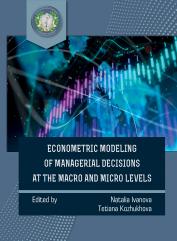CHAPTER 8 Making optimal decisions based on the development of the innovative potential of personnel
Keywords:
Managerial decision, Managerial decision, managerial decision making model, managerial decision making model, managerial decision making mechanism, managerial decision making mechanism, crisis, crisis, macroeconomic imbalances, macroeconomic imbalances, problem, problem, econometric approach, econometric approach, data-driven decision-making, data-driven decision-making, Highest Paid Person's Opinion, Highest Paid Person's Opinion, data-driven decision making capability, data-driven decision making capability, nformation and analytical support of managerial decisions, nformation and analytical support of managerial decisions, regression model, regression model, econometrics, econometrics, canonical analysis, canonical analysis, taxonomic analysis, taxonomic analysis, cluster analysis, cluster analysis, principal component method, principal component method, tree of opportunities, tree of opportunities, migration policy, migration policy, economic security, economic security, innovative development, innovative development, living standards of the population, living standards of the population, innovation infrastructure, innovation infrastructure, development management, development management, local development strategies, local development strategies, regional tourism markets services, regional tourism markets services, tourism, tourism, hotel and restaurant industry, hotel and restaurant industry, personnel innovation potential, personnel innovation potential, strategic management, strategic management, cognitive model, cognitive model, strategic process concept, strategic process concept, strategic decision, strategic decision, strategic change, strategic change, SWOT analysis, SWOT analysis, Potential square, Potential square, competitiveness, competitiveness, efficiency, efficiencyAbstract
In order to effectively develop enterprises to ensure the adoption of optimal decisions, a theoretical and methodological approach has been developed to assess the components of the innovative potential of personnel, which are decisive for making optimal decisions based on the "tree of opportunities" and the integral indicator of the innovative potential of personnel, contains complex indicators for assessing innovative activity personnel, innovative development of the enterprise, the degree of development of the enterprise.
Based on the process-analytical generalization, an algorithm for making optimal decisions based on the development of the innovative potential of personnel has been developed, namely: identifying the problems of enterprise development; search for the reasons for the retardation of the development of the enterprise; determination of the reasons for the retardation of the development of the enterprise; determination of optimal solutions depending on the formulated problem; development of recommendations for achieving strategic goals, based on the construction of a "tree of opportunities".
To solve the tasks and test the initial assumptions, a set of methods was used that reflect the unity of the theoretical and empirical levels of knowledge. Theoretical: methods of scientific analysis and generalization of experience in making managerial decisions, comparative method, modeling method; empirical methods: experiment, testing, questioning, content analysis, expert assessments, as well as mathematical and statistical methods for processing experimental data using the SPSS application package and logical and mathematical modeling using the construction of Euler circles.

ECONOMETRIC MODELING OF MANAGERIAL DECISIONS AT THE MACRO AND MICRO LEVELS


